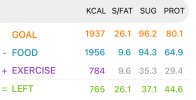Hi,
Firstly, hello! It's lovely to be here. It looks like a great place to get information 🙂
Can anyone help clarify something please? A recent blood test put me in the pre-diabetes range (43mmol/mol) so obviously I need to get it back down to a normal level. This happened once before a couple of years ago when I was at 45mmol and managed to get it down to 42.
My question is about fruit. I’ve read so much about the sugar in fruit being ok to have and not affecting the blood sugar level, so that’s all good. The problem I have is that I don’t really like fruit that much on its own so I bought a blender. I’ve heard various comments about blended fruit. Some saying that the sugars in the fruit are just as healthy as when the fruit is whole, others saying that you should not eat blended fruit as the sugars are then too high. I’m not talking about shop bought smoothies of course. I know these are ridiculously high in added sugar. I’ve found so many recipes that I find delicious and filling, for example a blend of skimmed milk, banana, frozen fruit, peanut butter & oats, but I worry when I see how much sugar is shown for this, and other similar things, in the app that I use (NutraCheck calorie counter). I've attached a screenshot of yesterday's daily total. As you can see, my sugar intake looks ridiculous! But if it's mostly fruit and dairy then I presume this is okay?
I’ve also seen confusing comments about grapes. Some saying that grapes, especially red ones, are extremely good for you, but others saying they are like “mini sugar bombs” and they should be avoided.
I’m so confused and worried that I’m doing this all wrong
Firstly, hello! It's lovely to be here. It looks like a great place to get information 🙂
Can anyone help clarify something please? A recent blood test put me in the pre-diabetes range (43mmol/mol) so obviously I need to get it back down to a normal level. This happened once before a couple of years ago when I was at 45mmol and managed to get it down to 42.
My question is about fruit. I’ve read so much about the sugar in fruit being ok to have and not affecting the blood sugar level, so that’s all good. The problem I have is that I don’t really like fruit that much on its own so I bought a blender. I’ve heard various comments about blended fruit. Some saying that the sugars in the fruit are just as healthy as when the fruit is whole, others saying that you should not eat blended fruit as the sugars are then too high. I’m not talking about shop bought smoothies of course. I know these are ridiculously high in added sugar. I’ve found so many recipes that I find delicious and filling, for example a blend of skimmed milk, banana, frozen fruit, peanut butter & oats, but I worry when I see how much sugar is shown for this, and other similar things, in the app that I use (NutraCheck calorie counter). I've attached a screenshot of yesterday's daily total. As you can see, my sugar intake looks ridiculous! But if it's mostly fruit and dairy then I presume this is okay?
I’ve also seen confusing comments about grapes. Some saying that grapes, especially red ones, are extremely good for you, but others saying they are like “mini sugar bombs” and they should be avoided.
I’m so confused and worried that I’m doing this all wrong

